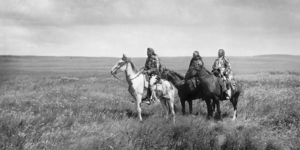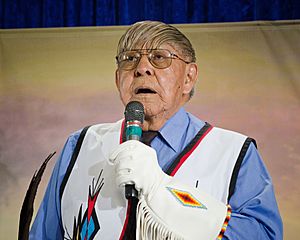Piegan Blackfeet facts for kids
| Total population | |
|---|---|
| 2010 census: total of 105,304 (alone and in combination) | |
| Regions with significant populations | |
| United States (Montana) | |
| Languages | |
| English, Blackfoot | |
| Religion | |
| Christianity, Traditional beliefs | |
| Related ethnic groups | |
| other Blackfoot peoples (Kainai and Siksika Nations), and Algonquian peoples |

The Piegan (also called Piikáni in their own language) are a group of Native Americans from the Great Plains in North America. They speak a language from the Algonquian family. The Piegan were the largest of three main groups that formed the Blackfoot Confederacy. The other two groups were the Siksika and the Kainai. The Piegan were very powerful in the northern Great Plains during the 1800s.
Later, their lands were divided by the borders between Canada and the United States. The Piegan people had to sign agreements with one of these countries. They settled on special lands called reservations or reserves. Today, there are two main groups of Piegan people. One is the Blackfeet Nation in Montana, U.S. The other is the Piikani Nation in Alberta, Canada.
Many Piegan people today live with the Blackfeet Nation in northwestern Montana. Their main office is in Browning. In 2010, over 105,000 people in the U.S. said they were Blackfeet. This number includes people who are fully Blackfeet and those who have Blackfeet heritage along with other backgrounds.
Contents
Understanding the Piegan People
The Piegan (also known as Pikuni or Piikáni) are one of the three original groups of the Blackfoot Confederacy. A "tribe" here means a group of people who share a name and culture. The Piegan are closely related to the Kainai Nation (also called the "Blood Tribe") and the Siksika Nation (also called the "Blackfoot Nation"). Sometimes, all three groups are called "the Blackfoot" or "the Blackfoot Confederacy".
In Canada, people often use "Blackfoot" to talk about the group. In the United States, the tribal governments and the U.S. government often use "Blackfeet." For example, the official website uses Blackfeet Nation. An individual might say, "I am Blackfoot" or "I am a member of the Blackfeet tribe."
In the past, Plains peoples lived in smaller groups called "bands." These were families who traveled together to hunt and protect themselves. Some of the Piegan bands included the Ahahpitape, Kiyis, and Kutaiimiks.
History and Connections

Scientists have studied the DNA of a very old baby skeleton found in Montana. This skeleton is over 12,500 years old. It shows strong links to all Native American groups living today. This suggests a long history of people in the area.
There is also early proof that people lived in north central Montana about 5,000 years ago. They used buffalo jumps to hunt bison as early as 300 AD.
The Piegan people might have arrived in this area more recently. Evidence suggests their ancestors, who spoke Algonquian languages, moved southwest around 1730. Before that, they may have lived further east, near the Great Lakes.
The Blackfoot language is part of the Algonquian language family. Studies show that the Blackfoot people lived west of the Great Lakes for a long time. Their language is "agglutinative," meaning words are formed by adding many parts together.
The Piegan people used to do some farming and also moved around. They moved westward after they started using horses and guns. These tools helped them hunt bison over a much larger area. By the early 1800s, they were a key part of the Plains Indians cultures. Their own stories say that humans have lived near the Rocky Mountain Front for thousands of years. The Blackfoot creation story is set near Glacier National Park.
Horses arrived around 1730. The Piegan got horses from other tribes like the Kutenai, Salish, and Nez Perce. Europeans first met the Piegan in the late 1700s. A fur trader and an explorer named David Thompson camped with a Piegan group in 1787-1788.
In the 1800s, the Piegan population sometimes dropped greatly. This was because of diseases like smallpox, which they had no protection against. The 1837 smallpox outbreak killed thousands of Blackfeet people. They also suffered from starvation when their food sources were disrupted. The year 1882 is known as the "starvation year" because the last buffalo hunt failed. In the early 2000s, there are more than 35,000 Blackfeet people.
The Blackfeet once controlled large parts of Alberta and Montana. Today, the Blackfeet Reservation in Montana is about the size of Delaware. The three Blackfoot reserves in Alberta are much smaller.
The Blackfeet believe in a special power that is in all things. They see the sun as a symbol of this power because its light helps everything live.
Important Piegan People
- Earl Old Person (1929– ): He was a long-time Chief of the Blackfeet Tribe. He was added to the Montana Indian Hall of Fame in 2007.
- Helen Piotopowaka Clarke (1846–1923): She was an actress, teacher, and government worker. She was one of the first women elected to public office in Montana.
- James Welch (1940–2003): He was a famous author and poet. His novel Fools Crow is about the Blackfeet tribe and their culture. He also wrote a non-fiction book about the Battle of Little Bighorn.
- John Two Guns White Calf (1872–1934): He was a chief who became well-known for promoting Glacier National Park for a railway company.
- Stephen Graham Jones (1972- ): He is an author who has won many awards for his writing.
Books About the Blackfeet
- George Bird Grinnell (1849–1938): He was a European-American author and ethnologist (someone who studies cultures). He wrote about the Blackfeet Nation during his travels.
- James Willard Schultz (1859–1947): Also known as Apikuni, he was an author, explorer, guide, and historian of the Blackfeet Indians. He wrote 37 books, both fiction and non-fiction, about the Blackfeet and other tribes. His books were highly praised.


